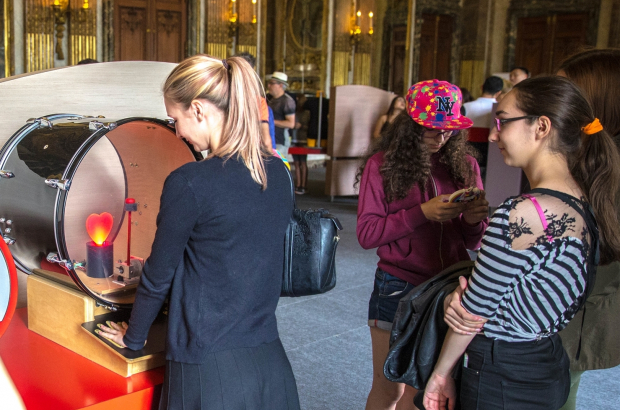- Daily & Weekly newsletters
- Buy & download The Bulletin
- Comment on our articles
Exhibitions at royal palace combine science, culture and webcams
Every summer, the royal palace in Brussels throws open its doors to the general public. In addition to strolling around the richly decorated rooms, visitors can also enjoy three exhibitions on science and culture.
Heaven! in the Throne Room showcases artworks and materials focused on the mysteries of the skies. The show was organised by the Brussels chapter of the National Geographic Institute and together with all 10 of the country’s federal scientific institutions.
Among the objects on display are instruments that are no longer used for scientific purposes, but that still have plenty to trigger the imagination. They include 18th-century armillary spheres and a 19th-century actinograph, an instrument that makes it possible to estimate the amount of light available to expose film.
Several historical documents are also on view, such as a map of the moon made by a 17th-century astronomer and a 15th-century manuscript that includes an image depicting the creation of heaven. A much, much older artefact here is the lid of an Egyptian coffin. It sports an image of Nut, the goddess of the sky in Egyptian mythology.
The Heaven! exhibition also features more contemporary installations. Visitors can, for example, observe the peregrine falcons nesting at the top of the capital’s St Michael and St Gudula Cathedral via webcam images. Videos also allow visitors to glimpse astronauts at work in the International Space Station and watch biologists use balloons to examine treetops in tropical rainforests.
The human body, explained
Meanwhile, the hands-on science centre Technopolis in Mechelen has taken over the palace’s Mirror Room for 12 exhibits that make up the To Your Health! exhibition on the human body. This show, which is mainly targeted at youngsters, demonstrates just how fast the human heart beats and how much energy is derived from food in fun, interactive installations.
Finally, an exhibition in the palace’s Great Gallery organised by the Royal Association of Dynasty and Cultural Heritage digs into the life and art of the 20th-century royal Karel van Vlaanderen. Prince Charles played an important political role as a regent during and briefly after the Second World War, but he viewed himself as an artist first and foremost. Or to put it in his words: “I am an artist unlucky enough to be a prince.”
The expo, Karel van Vlaanderen, Prins, Regent, Kunstenaar (Charles of Flanders, Prince, Regent, Artist) offers an overview of his life and decisive moments. During the First World War, he was sent to England, where he enlisted with the British navy. Watercolours he included in a logbook during a trip to the Far East during this time already hint at his ambitions as a painter.
In 1944, Prince Charles was asked to take over the reins of the country from his brother King Leopold III. The exhibition doesn’t focus on the political controversies surrounding the figure of Leopold, whose outsized political ambitions divided the country and who was ultimately forced to pass down the throne to his son Boudewijn.
Instead, the exhibition explores how Charles, prince regent from 1944 to 1950, accelerated the country’s post-war reconstruction and helped put it on the international map through his visits to many countries, including Canada and the US.
After 1950, Charles retreated to his domain in Raversijde at the Belgian coast to devote himself to drawing and painting. The expo includes his sketch portrait of the Spanish surrealist artist Salvador Dalí during this time and gives an overview of the diverse styles that the artistic prince experimented with – from expressionism to abstract art.
Until 3 September, Royal Palace, Place des Palais, Brussels. Photo courtesy Royal Palace









